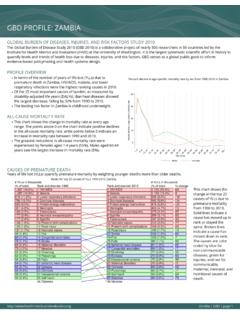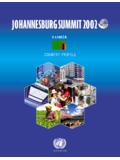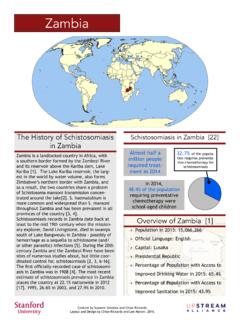Transcription of Rice production diagnostic for Chinsali and Mfuwe, Zambia
1 rice production diagnostic for Chinsali ( Chinsali District, Northern Province) and Mfuwe (Mwambe District, Eastern Province), Zambia By Erika Styger July 2014 For COMACO and David R. Atkinson Center for Sustainable Development rice diagnostic for Chinsali and Mfuwe, Zambia ; by Erika Styger, Cornell University, July 2014 2 rice production diagnostic for Chinsali ( Chinsali District, Northern Province) and Mfuwe (Mwambe District, Eastern Province), Zambia Written by Erika Styger, SRI International Network and Resources Center (SRI- rice ), International Programs, College of Agriculture and Life Sciences, Cornell University, Ithaca, NY, USA All photos by Erika Styger For COMACO, Lusaka, Zambia and David R.
2 Atkinson Center for a Sustainable Future, Cornell University, Ithaca, NY, USA 2014 SRI International Network and Resources Center (SRI- rice ), Ithaca, NY For more information visit , or contact Erika Styger rice diagnostic for Chinsali and Mfuwe, Zambia ; by Erika Styger, Cornell University, July 2014 3 Table of Content Table of Content 1. Introduction 2. rice systems in Zambia and COMACO rice production zones 3. Northern Floodplain rice production zone, Chinsali District, Northern Province Agricultural system overview rice production practices The application and performance of the System of rice Intensification Challenges and constraints to rice intensification Description of three lowland rice production zones in Chinsali Adaptation to climate variability opportunities for intensification Chama rice quality loss Implementation strategies for rice intensification for the 2014/2015 cropping season 4.
3 Dambo rice production Zone, Mfuwe, Mwambwe District, Eastern Province Agricultural system overview rice production practices and use of the SRI methodology Challenges and constraints Opportunities for intensification 5. Final conclusions and recommendations 6. Bibliography Annex 1: Program of Zambia visit, Erika Styger Annex 2: Agro-ecological regions of Zambia Annex 3: COMACO areas of operations Annex 4: Proposed Harvesting of rice Plots in Chinsali and Mfuwe Area, Annex 5: rice Harvesting Guidelines for Yield Evaluation for COMACO Annex 6: SRI Planning and Field Preparation Timeline Annex 7: SRI Crop Management Timeline 3 4 7 9 9 10 11 13 15 16 18 20 23 23 24 30 31 36 36 37 38 39 40 42 50 51 rice diagnostic for Chinsali and Mfuwe, Zambia .
4 By Erika Styger, Cornell University, July 2014 4 1. Introduction The Zambian Ministry of Agriculture and Livestock has designated rice as one of the strategic food crops for Zambia , in addition to maize, cassava, sorghum, millet, sweet and Irish potato, and wheat. rice is also recognized as having the potential to significantly increase incomes and employment among rural producers. One of the main government strategies for the agricultural sector is to diversify the range of competitive crops other than maize by focusing on increasing productivity and value addition of the selected crops (Republic of Zambia , 2011 and 2014).
5 Among all staple food crops in Zambia , rice is the only one in deficit, and the deficit increases every year. Although rice production in Zambia has tripled since early 2000 from about 17,000 MT/year to an estimated 47,000 and 54,000 MT/year in 2010 and 2013, respectively, rice consumption for the latter period was between 62,500 MT and 66,500 MT, creating an estimated annual rice deficit of 12,500-15,000 MT. Indeed, per capita consumption of rice increased from in 2002 to in 2013. Zambia 's 64,500 rice farmers each produce on average less than 1 MT of rice /year (Republic of Zambia , 2011 and 2014).
6 rice is mostly grown in the Northern and Eastern Provinces, which overlaps with COMACO s intervention zone (see map next page), and in the Western Province around Mongu. Because these rice -growing regions are quite isolated from the major urban markets, it is a challenge to profitably produce and market rice in Zambia (Sitko et al, 2011). Nevertheless, potential to increase rice production is high. Large areas of land suitable to rice production are available and there is a high consumer demand for local rice .
7 Zambians favor the local varieties from Mongu, Nakonde and Chama over imported rices due to the aroma, cooking quality and white color of the local rices. (Cited by Sitko et al, 2011) Community Markets for Conservation (COMACO) is a limited-by-guarantee, non-profit company doing business as COMACO Ltd. COMACO s vision is to secure the Luangwa Valley ecosystem from human disturbance by creating livable incomes and food security for the population living in proximity to the Southern and Northern Luangwa, Luambe, Lukusuzi, and Lower Zambezi National Parks and the surrounding natural areas.
8 Through trade incentives and markets, farmers are given the opportunity to produce and sell organic products, while protecting and managing the associated natural resources and landscapes sustainably. rice diagnostic for Chinsali and Mfuwe, Zambia ; by Erika Styger, Cornell University, July 2014 5 The company is primarily a food-processing business that markets organic, healthy, nutritious value-added products derived from commodities grown by farmers i) who live in proximity to protected wildlife and forest areas and ii) who are members of COMACO producer groups.
9 Products marketed under the IT'S WILD! brand to Zambia s urban consumers include, among others, Chama rice , peanut butter, Yummy Soy, groundnuts and honey. This innovative model has proven to be very successful. In 2013, COMACO worked across the Luangwa valley in 54 chiefdoms, with more then 80,000 farmer-members organized into 3,939 producer groups. COMACO's year-round field support to farmer-members is provided by 1,139 lead farmers, 28 senior lead farmers and 40 area managers (COMACO, 2014). rice has become COMACO s most important product.
10 During the 2012 season, rice made up of COMACO sales, followed by peanut butter at Market share for other products was much smaller: honey at , and less than 2% each for all other products such as beans, dried mangoes, and wild mushrooms (COMACO, 2012). rice diagnostic for Chinsali and Mfuwe, Zambia ; by Erika Styger, Cornell University, July 2014 6 Following a thorough selection process of the regional rice varieties, COMACO identified a local variety from the Chama District to be the most attractive variety for the local market, now produced and marketed under the name Chama rice .










